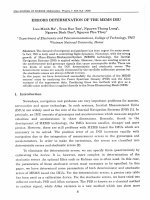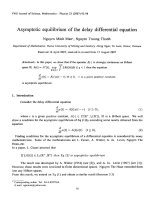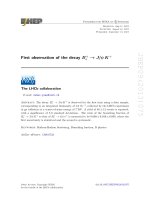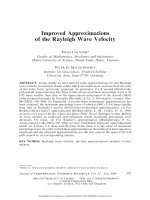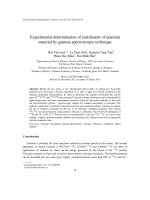DSpace at VNU: Errors determination of the MEMS IMU
Bạn đang xem bản rút gọn của tài liệu. Xem và tải ngay bản đầy đủ của tài liệu tại đây (4.86 MB, 9 trang )
VNU JOURNAL OF SCIENCE, Mathematics - Physics, T. XXII, N04 - 20 06
E R R O R S D E T E R M I N A T I O N O F T H E M E M S IM U
L u u M a n h H a 1 , T r a n D u e T a n 1, N g u y e n T h a n g L o n g 1,
N g u y e n D i n h D u e 2, N g u y e n P h u T h u y 1
1D epartm ent o f Electronics an d Telecommunications, College o f Technology, V N U
2Vietnam National University, H anoi
Abstract. The demand of navigation and guidance has been urgent for many years.
In fact, INS is daily used in controlling flight dynamics. Nowadays, with the strong
growth of Micro-Electro-Mechanical-System (MEMS) technology, the Inertial
Navigation Systems (INS) is applied widely. However, there are existing errors in
the accelerometer and gyroscope signals that cause unacceptable drifts. There are
two kinds of noise in the INS: deterministic and stochastic errors. The
deterministic noises are usually eliminated by the carefully calibration process but
the stochastic noises are always difficult to treat.
In this paper, we have determined successfully the characteristics of the MEMS
sensors’ noise by analyzing the Power Spectrum Density (PSD) and the Allan
variance of the experiment data. Combining these two methods will give us a
reliable noise model that is applied directly to the Noise Eliminating Block (NEB),
1. In tr o d u c tio n
Now adays, navigation and guidance a re very im p o r ta n t problem s for m arine,
aero nautics a n d space technology. In such system s, I n e rtia l M e a s u re m e n t U nits
(IMUs) are widely used as the core of the In e rtia l N avigation S y stem s (INS) [1]. In
principle, an IMU consists of gyroscopes and accelerom eters which m easure a n g u la r
velocities
and
accelerations
in
th ree
dim ensions.
Recently,
th a n k
to
the
developm ent of MEMS technology, the IMƯS become sm aller, c heaper and more
precise. However, th ere are still problem s w ith M EM S b ased th e IM U s which are
necessary to be solved. The position error of an IN S in cre ases rapidly with
navigation d ue to the in te g ratio n of m e a su re m e n t e rro rs in the gyroscopes and
accelerom eters. In order to m ake the corrections, th e e rro rs a re classified into
deterministic e rro rs a n d stochastic e rro rs [2],
To e lim in a te the determ inistic errors, we can specify th em q u a n titativ e ly by
calibrating th e device. It is, however, more complex in d e te rm in a tio n of the
stochastic e rro rs .An optim al filter such as K alm an one is often used. In this case,
the p a ra m e te rs of those stochastic erro rs m u st n e cessary to be specified. In this
paper, we h a v e d e te rm in e d noise p a ra m e te rs of both d e te rm in istic and stochastic
errors of M EM S based the IMƯS. For the d e te rm in istic errors, a precise ra te table
has been used as a calibration device. For the stochastic erro rs, we have trie d two
different m ethods PSD and Allan variance. The PSD is know n as a classical method
to analyze signal, while A llan variance is a new m ethod which can show more
6
E rrors D e te r m in a tio n o f the M ems IMU
7
in fo rm atio n t h a n th e PSD. Com bining these two m ethods will give us a reliable
noise model t h a t is app lied directly to the Noise E lim in atin g Block (NEB).
2. M e a s u r e m e n t a n d c h a r a c te r iz a tio n
In th is s tu d y , we used the MICRO-ISƯ BP3010 which consists of th ree
ADXRS300 gyros a n d th re e h e a t compensated ADXL210E accelerom eters [3]. The
m e a s u re m e n ts a re sy n th e size d by IMU’s micro-controllers and tr a n s m itte d out via
RS232 in terface. T he u n it tr a n s m its o u tp u t d a ta as a n g u la r in cre m e n tal and
velocity in c r e m e n ta l d a ta in serial fram es of 16 bytes a t one of the user-selectable
frequencies of 64 Hz, 32 Hz, 16 Hz or 8 Hz.
F igure 1: T he MICRO-ISU BP3010 - A MEMS unit.
2.1 D e te r m in is tic errors
D e te rm in istic e rro rs consist of bias, scale factor, in e rtia l axis m isalignm ent
t h a t a re c o n sidered by the following error model [2]:
Sabx = a x + a xxa xh + a xya yb + a x.a hz
Sah
y = a y + a yxa xh + a ^ a ị + a r a z
Sa\ = a z + a a aỊ + a .ya yb + a a a\
H
=A +A X +
H
= / * , + 4 X + / ? x + 4 X +(Pm a i + p yy y
Scob
: = p z + Pzxcoh
x+
+PXA
+ ( Ạ X + Pxyyab
y + Pxyiab
2)a>b
y +{Pxzxab
x +(ixzyaby +
+ PIzcob
: + (Pzy x +
+Ạ X K
+(& x +
)(0b
y
(1)
w here ổũị ,ôũ)ị ( i = X, y, z) a re accelerom eter and gyroscope e rro rs expressed in the
body fram e.
ữị - A ccelerom eter b iases [m/s2].
a u - A ccelero m eter scale factor [unit less].
GCjj - A ccelerom eter in s ta lla tio n error (/ ^ j ) [unit less].
- A c celero m eter o u tp u t in body fram e coordinates [m/s2].
Luu M anh Ha, Tran D ue Tan, Nguyen Thang Long...
8
/? - Gyro biases [rad/s],
p.. - Gyro scale factor [unit less].
- Gyro in stallatio n error (i * j ) [unit less].
P ik - Gyro drift depending on acceleration, flexure e rro r [m/s2]
ứ / 'G yro o u tp u t in body fram e coordinates [rad/s].
In th is paper, all in stallatio n errors and flexure e rro rs will be neglected
because they are very sm all. All of rem ainin g d e te rm in istic e rro rs are d eterm ined
by the accelerom eter a n d gyroscope calibrations.
a) Accelerometer calibration
u
Ạ z
N
Figure 2: In itial IMU position for up-down calibration.
In the calibration procedure of the accelerom eters, th e e a r t h gravity h as been
used. In this method, th e IMƯ is initially positioned so t h a t th e Z-axis of the IMƯ
aligned w ith the location level fram es U-axis, the Y-axis of th e IMU aligned with
the N-axis and the X-axis aligned w ith the E-axis (Fig.2). It m e a n s th a t th e gravity
component will affect only the accelerom eter along Z-axis by a n a m o u n t of +g (g 9.8 m/s2). If the IMƯ is th e n ro ta te d 180° around th e Y-axis, a new m ea su re m e n t
could be ta k e n when the accelerom eter along Z-axis sen ses the negative gravity (-g ).
W hen the IMU w ith the ith accelerom eter aligned w ith th e U-axis in the
navigation frame, the o u tp u t of th e accelerom eter is:
z \ a Ị ) = a { + ( a u + \)g
(2)
R otating th e IMU 180° a roun d p erp e n d icu lar axis a n d m ak in g a n oth er
m easurem ent will give the following o u tp u t of the accelerom eter:
z2( a . ) = a ị - ( a
a
+ l)g
(3)
Errors D e te rm in a tio n o f the Mems IMU
9
Solving se t of e q u a tio n s (2) and
accelerom eter b ia s a n d scale factor:
(3) above,
and
we can
e stim ate
of the
, ' ( « * ) - , ’ („,»)
2
2g
"
The collecting d a ta process is perform ed for about 10 m in utes for each
position, th e n th e d a ta is a v erag e d to give z '(a * ) a n d z 2(a*). S et of equations (4) is
finally used to e x tra c t th e accelerom eter bias an d scale factor. Calibration results
showed t h a t th e accelerom eter along Z-axis h a s bias of 0.1330 m/s2 and scale factor
of 0.0041.
b) Gyroscope calibration
The m e th o d is a c alib ratio n procedure t h a t uses a precise ra te table which
contains se q u en c e of d ifferent ra te s for each dim ension h a s been m ade use. The
IMU is in itia lly positioned in center of
ra te table and each ra te is ru n
approx im ately for 10 m in u te s.
The e rr o r model e q u a tio n of the gyro is:
w*i =
fit
+ (A i + ! ) ( Wy +
)
(5)
where w . is n o m inal gyro a n g u la r ra te a t table a n g u la r ra te Wj [deg/h, rad/s].
Wj . a v e ra g e table a n g u la r ra te for d ata segm ent j [deg/h, rad/s].
wex. se n se d com ponent of e a r th rotation ra te [deg/h, rad/s].
p ị - gyro b ias [deg/h, rad/s].
Pii - gyro scale factor.
From (5), we have:
_ K . - w ) - ( „ )
(w, - w2)
and
_
_
2
+
(6)
2
We can th e n e s tim a te gyro bias scale factor based on Eq.6. R esu lts showed
th a t the Z-axis gyro h a s b ias of 0.3172 °/s and scale factor of -0.0070.
2.2 S to c h a s tic IM U errors
Some stochastic errors th a t affect the Initial Navigation Systems are listed as
follows.
- Q u a n tiza tio n noise
Q u a n tiz a tio n noise is m ade from encoding the analog signal into digital form.
This noise is c au se d by th e sm all difference betw een th e a c tu al a m plitud es of the
sam pled sig n a l a n d b it resolu tion of A-D Converter. We can reduce quantization
noises by im p ro ving encode m ethods, adju stin g sam ple rate , or increasing bit
resolution.
- W hite noise
Luu M anh Ha, Tran Due Tan , Nguyen Thang Long..
10
W hite noise can be a major source of the IMƯ e rro rs an d it h a s a c o n stan t
power spectrum over whole frequency axis. Angle random w alk (for gyroscope) and
velocity random walk (for accelerom eter) are caused by th e w hite noise.
- R a n d o m walk
This is the random process of u n certain origin, possible of a lim iting case of an
exponentially correlated noise with long correlation tim e. The gyroscopes a re
affected by a n g u la r ra te random walk, while th e accelerom eters a re affected by
acceleration random walk.
- Flicker noise
Flicker noise is low-frequency noise term th a t shows as bias fluctuations in
data. This noise is caused by the electronics or o th e r com ponents t h a t are
susceptible to random flickering.
In o rder to analyze stochastic IMU errors, we have used the following
methods:
a) Power spectral density analysis
The Pow er Spectral D ensity Analysis (PSD) describes how the power is
allotted along th e frequency axis [4]. The o u tp u t d a ta of th e IMU, which is collected
during an hour, is analyzed to give th e PSD. Fig.3 shows a log'log plot of th e PSD of
the X-axis gyro. We note t h a t th ere is a bunching of high frequency area. It IS
difficult to identify the noise term s and the p a ra m e te rs asso ciated w ith them . Thus,
the frequency a v erag in g technique [5] h as been used to sm ooth the PSD plot.
a
b
Figure 3.T he PSD plot of the X-axis gyro (a) and th e PSD plot ob tain ed by the
frequency averaging technique (b)
Fig.3.b show s th e PSD plot of the X-axis gyro obtained by the frequency
averaging technique. The slopes of the curve comprise -2, 0 and 2. It m eans th a t the
gyro data includes the angular rate random walk, th e angle random walk and the
quantization noise. The PSD of the X-axis gyro (see Fig. 3b) doesn’t have the
inclination o f —1, which m eans th a t the Z-axis gyro lacks the a n g u la r rate flicker noise.
E rrors D e te rm in a tio n o f the Mems IMU
11
Figure 4. T he PSD of accelerom eter z obtained by frequency averaging technique
Fig.4 show s th e PSD plot of Z-axis accelerom eter obtained by using the
frequency a v e ra g in g tech niq ue. The slopes of the curve comprise -2, -1, 0 1 and 2.
This curve in d ic a te s t h a t accelerom eter d a ta includes acceleration random walk
acceleration flicker noise, velocity random walk, and acceleration quantization
noise.
By u sin g th e conv ertin g form ula in [6], we obtain from the PSD plot the
a n g u la r ra te w h ite noise a n d th e acceleration w hite noise as listed in T ab .l.
T a b l e 1. E s tim a te d white noise in th e in e rtia l sensors.
Noise term
X
Y
z
Angular rate white noise °l4h
0,0560
0,0486
0,0578
Acceleration white noise (m/s)/ 4 h
0.0033
0,0030
0,0028
Analog Device s ta te s t h a t a n g u la r random walk h a s values from 0 to 6°/4 h for
the ADXLS300 gyros used in th e MIRCO ISU BP3010 ỈMU. If we compare it to
Table 1, we can see t h a t the w hite noise level indeed lies w ithin th e limit of the
m an u fa ctu rer.
b) A lla n variance an a lysis
The A llan v a ria n c e is sta tistic a l m easu re to characterize th e stability of a
tim e-frequency sy ste m [7]. T he PSD can only e x tra ct w hite noise sta n d ard
deviation. In c o n tr a s t, u sin g th e Allan variance, several o th e r e rro r p a ra m eters can
be com prehensively derived.
The basic id e a of th e A llan variance is to tak e a long d a ta sequence and divide
it into se g m en ts b a se d on a n a v erag in g t i m e r to process. Let give a sequence with
N e le m e n ts y k , k= 0,1,..., N - l . Then, we define for each n = l ,2 ,3 ,...,M £ N /2 a new
sequence of a v e ra g e s of subsequence with length n:
Luu M anh Ha, T ran D ue Tan, N guyen T hang Long..
12
If th e sa m p lin g tim e is A / , th e tim e sp a n w ith in an a v erag e d sequence of
len g th n is r = n A t . T h e A llan v a ria n ce , for a given su bsequ ence length n, is
defined as:
'N'1 - 2
-
1
c r l ( T ,N ) t . (
~N~
2
-1
\ n
/
T he
typical
slopes
of th e
A llan
2
]
( 8)
(x J+i ( n ) - X j ( n ) Y
j=0
v a ria n c e
for
th e
gyroscope
and
the
accelerom eters in log-log plot a re show n in Fig. 6 w ith d a ta collected from the IMU
ISƯ BP3010 d u rin g a n hour.
To d e te rm in e th e noise p a ra m e te r s , we n e ed to fit th e s t a n d a r d slopes in Fig 5
[8], For exam ple, if d a ta c o n ta in s w hite noise, th e slope -1/2 will a p p ea r in the loglog plot of th e A llan s t a n d a r d deviation.
Averaging tone (s)
Figure 5. T h e s t a n d a r d slopes of th e A llan s ta n d a r d deviation.
T he log-log plot of th e Allan s ta n d a rd deviation in Fig.6.a indicates th e presence
of a n g u la r ra te q u a n tiza tio n noise (slope -1), a n g u la r ra te w hite noise (slope -1/2),
an g u la r ra te ran dom w alk (slope 1/2), while a n g u la r ra te flicker noise (slope 0) is
absent. This resu lt is fully con sistent w ith t h a t o btained by the PSD plot.
F ig u re 6b show s th e log-log plot of th e A llan s t a n d a r d d eviation for the
accelerom eter. T h is show s th e presence of a c c elero m ete r q u a n tiz a tio n noise (slope I), a cc elero m ete r w h ite noise (slope -1/2), a c c elero m ete r flicker noise (slope 0), and
acceleration ran d o m w a lk (slope 1/2). T his r e s u l t is gain well c o n siste n t w ith t h a t
from th e PSD plot. In a d d itio n , th is shows th e p resen c e of a cceleratio n tre n d (slope
1) t h a t is u n a b le to be in d ic a te d by only u sing t h e PSD plot.
E rrors D e term in a tio n o f the Mems IMU
a
13
b
Figure 6. T he A llan s t a n d a r d deviation of gyro X (a) a n d of acc elero m ete r
z (b)
The w hite noise coefficient is o b tain ed by fittin g th e slope lin e a t r = 1. Below
the
table
shows
th e
e s tim a te d
noise
coefficients
for
th e
gyros
and
the
accelerom eters.
T a b l e 2. Id e n tifie d Noise Coefficients, u sin g A llan v a ria n ce .
Gyros
Qz(rad)
(Quantization
noise)
X
K(rad/s/Vi )
(white noise)
B (rad/s)
(Flicker
noise)
1,504*10-®
1.368M0-5
X
5,617*1 O'7
X
Y
1,655*106
1,517*1 o*5
5,315*10*
X
X
z
1,668*10'6
1,535*10-5
5,556'IQ-6
4,892*10'7
X
K (m/s2/ V T )
R(m/s3)
Accelerometers
Qz(m/s)
Q(radI y f s )
Q(m/s/ yfs )
B(m/S2)
(random
walk)
R (rad/s2)
(trend)
X
1,352*10-5
4,734*10'5
4,155*10'5
1.161*105
X
y
1,400*105
5,169*10'5
4,713*10'5
7,588’ K)-6
5.0685*107
z
1,339*10 5
5,688‘ 10'5
4,025*10'5
9,197*10-«
7.4025*1 O'7
C h a ra c te r X m e a n s t h a t th e sen sor lacks th e e rro r or th is one is m uch sm a ller
th an the others.
c) Com parison between P S D a n d A lla n variance
Table 3 show s th e com parison b etw een th e PSD a n d A llan v a ria n ce in
extracting w hite noise coefficients. The r e s u lts o b ta in e d by th e two m eth o d s a re
much closed w ith each o th e r w hich confirm ed a s s e r t th e relia b ility a n d th e accuracy
of the e rro r model a p p lied to th e practical I n e r tia l N a v ig a tio n S ystem s.
Luu Manh Ha, T ran Due Tan , N guyen T h an g Long...
14
T a b l e 3. The com parison betw een th e PSD a n d th e A llan variance.
Accelerometers
Gyros
PSD ([°/VÃ])
Allan([°/V^ ])
PSD{[m/s/Jh ])
Allan [[m/s/yfh ])
X
0,0560
0.0470
0,0033
0,0028
Y
0,0486
0.0522
0,0030
0,0031
z
0,0578
0,0528
0,0028
0.0026
3. C o n clu sio n
This p a p er h a s succeeded in specifying th e p a ra m e te r s of th e IMU errors,
which is a necessary step w hen applying erro r-p ro c essin g a lg o rith m s for the INS.
E stim ation of th e stochastic errors is more com plicated t h a n for th e determ inistic
ones. Both of the two m ethods, PSD and A llan v a ria n ce , hav e been used here to
estim ate the stochastic erro rs of the IMƯ. I t is show n t h a t th e A llan variance is the
more com prehensive m ethod. The extracted r e s u lts will be used as the p aram eters
in K alm an filter for the INS-GPS in te g rate d system .
A ck n o w led g em en ts. This work is su ppo rted by th e VNU p ro g ram QGTD0509.
R eferen ces
1.
2.
3.
4.
5.
Vikas K u m a r N, Integration o f In ertial N a v ig a tio n S y ste m a n d Global
Positioning S ystem Using K a lm a n F iltering , M .Tech. D issertatio n , Indian
In s titu te of Technology, Bombay, Ju ly 2004.
Oleg S. Salychev, A p p lied Inertial N avig ation : P roblem s a n d Solutions, BMSTU
Press, Moscow R ussia, 2004.
Georey J.B u lm er, In M IC R O -IS Ư B P 3 0 1 0
A n O E M M in ia tu re Hybrid 6
Degrees-Of-Freedom Inertial Sensor Unit. Gyro S y m p o s iu m , S t u t t g a r t 16th-17th
Septem ber, 2003.
P e ter s. Maybeck, Stochastic models, estim a tio n , a n d control, Academic Press,
Vol. 1, 1994.
IE EE Std 1293-1998, Ieee s ta n d a rd specification fo rm at guide and test
procedure for single - a x i s in terferom etric fiber optic gyros.
6.
Wang, J., Lee, H.K., Rizos, c ., G P S / I N S In tegration : Ả
S ensitivity A na lysis, U n iversity of New S o u th W ales, Sydney.
Performance
7.
Haiying Hou, M odeling inertial sensors errors u sin g A lla n variance, ƯCEGE
reports n u m b er 20201, M aster's thesis, U n iv e rs ity of C algary, Septem ber 2004.
8.
Gyro, Accelerom eter P a n e l of the IE E E A erospace, and Electronic Systems
Society, D raft recom m ended practice for in e r tia l sen so r te s t equipm ent
in stru m e n ta tio n , d a ta acquisition and a n aly sis. In IE E E S t d W o rkiig Drafi
P 1554/D 14.

